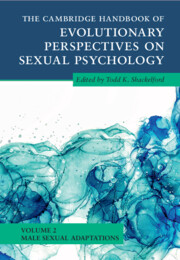Book contents
- The Cambridge Handbook of Evolutionary Perspectives on Sexual Psychology
- The Cambridge Handbook of Evolutionary Perspectives on Sexual Psychology
- Copyright page
- Contents
- Contributors
- Preface
- Part I Precopulatory Adaptations
- 1 Men’s Sexual Preferences
- 2 Men’s Extra-Pair Sexual Interest
- 3 Male Sexual Attraction Tactics
- 4 Men’s Intrasexual Competition
- 5 Competitiveness and Fatherhood as Overarching Domains of Female Choice in Human Evolution
- 6 Sexual Coercion and Rape
- 7 Mate Poaching by Men
- Part II Copulatory Adaptations
- Part III Postcopulatory Adaptations
- Index
- References
6 - Sexual Coercion and Rape
from Part I - Precopulatory Adaptations
Published online by Cambridge University Press: 30 June 2022
- The Cambridge Handbook of Evolutionary Perspectives on Sexual Psychology
- The Cambridge Handbook of Evolutionary Perspectives on Sexual Psychology
- Copyright page
- Contents
- Contributors
- Preface
- Part I Precopulatory Adaptations
- 1 Men’s Sexual Preferences
- 2 Men’s Extra-Pair Sexual Interest
- 3 Male Sexual Attraction Tactics
- 4 Men’s Intrasexual Competition
- 5 Competitiveness and Fatherhood as Overarching Domains of Female Choice in Human Evolution
- 6 Sexual Coercion and Rape
- 7 Mate Poaching by Men
- Part II Copulatory Adaptations
- Part III Postcopulatory Adaptations
- Index
- References
Summary
The imbalance of minimum obligatory parental investment between sexes has imposed distinct and often conflicting adaptive problems for males and females. One such adaptive problem faced by the less investing sex (males) is the acquisition of more reproductive opportunities with members of the more investing sex. One potential solution to this problem is the use of sexual coercion or force to nullify female mate choice. Although males of many species have been observed to employ coercion or force to achieve copulation, the extent to which human sexual coercion and rape are evolved behaviors remains an open question. The present chapter is a brief review of the comparative literature, as well as empirical research from a wide range of domains within human psychology, weighing support for both the adaptation and byproduct theories of rape in humans. The similarities in the sexually coercive behaviors of nonhuman primates, heritability of sexual offending, and the potential adaptive benefit of sexual coercion across various mating contexts provide considerable support for the evolution of rape in humans. Nevertheless, support in favor of the adaptation theory of rape is not necessarily exclusionary to the byproduct theory. Therefore, there remains a need for additional evolutionary research to contribute to this open question.
- Type
- Chapter
- Information
- Publisher: Cambridge University PressPrint publication year: 2022



